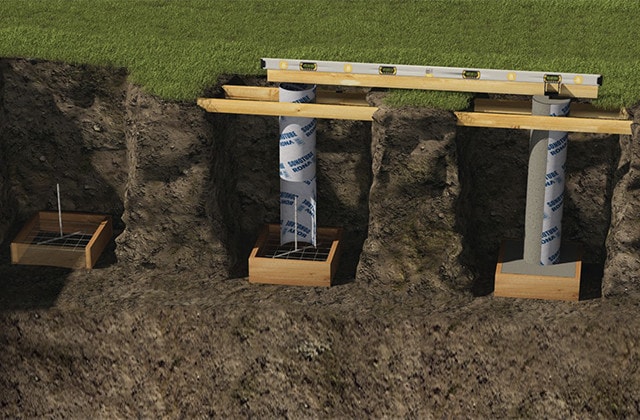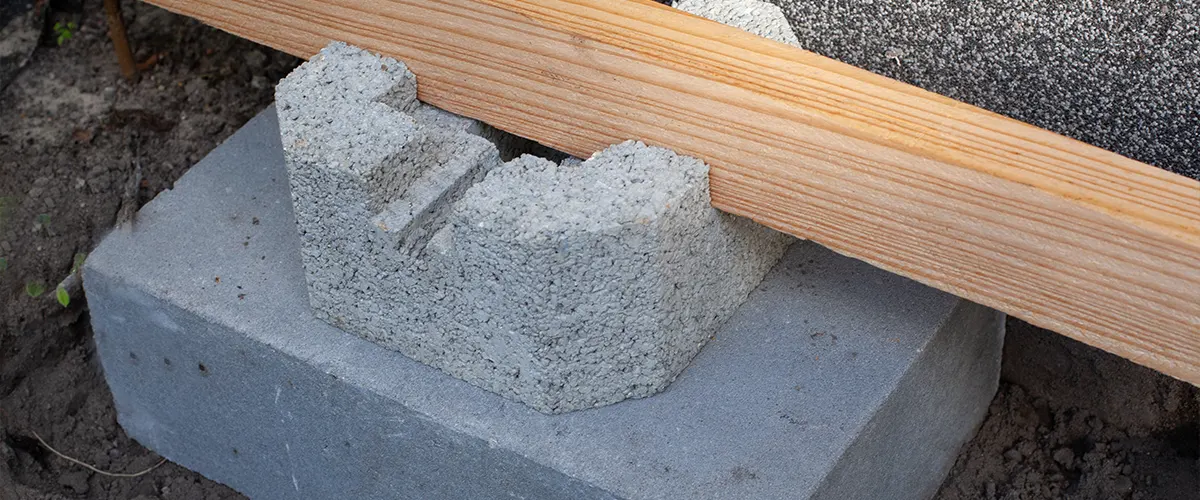Selecting the Right Deck Footings for Stability and Longevity
When it concerns developing a deck, among one of the most important decisions you will make is choosing the best grounds for security and resilience. The durability and security of your deck depend heavily on the type of footings you select, as they provide the essential assistance and stability to hold up against the examination of time. With a myriad of options available, it can be frustrating to figure out which grounds are best fit for your details demands. In this conversation, we will certainly explore the different sorts of deck grounds, consider the essential aspects to evaluate when deciding, and delve right into the benefits and drawbacks of various choices. By the end, you will have a more clear understanding of the options available and be better equipped to make an educated decision for your deck task.
Sorts Of Deck Footings
These grounds are composed of a round opening filled with concrete, which gives a strong structure for the deck blog posts. Concrete pier footings are fairly very easy to install and offer outstanding security, making them a prominent option for many deck jobs.
These grounds are mounted by screwing them into the ground, which creates a protected structure for the deck. They additionally permit for simple modification and leveling of the deck if needed.
Additionally, some home builders select precast concrete footings. These grounds are made of long lasting concrete and be available in various sizes and shapes to fit various deck styles. Precast concrete grounds are practical to mount and offer a stable base for the deck framework.
Ultimately, an additional choice is the post-in-anchor footing system. This kind of ground involves driving a metal anchor into the ground and connecting it to the deck message. It uses adaptability in terms of placing the deck articles and appropriates for decks with lightweight frameworks.
When choosing the appropriate kind of deck ground, it is vital to consider variables such as dirt problems, deck tons, and regional structure codes (Deck Footings). Consulting with a professional service provider or architectural designer can aid ensure the suitable ground is picked for a steady and risk-free deck
Variables to Think About When Choosing Footings
When picking the proper footings for a deck, it is crucial to very carefully consider different variables such as dirt conditions, deck tons, and adherence to local structure codes. These variables play a significant role in making certain the security and durability of the deck framework.
The kind of soil on which the deck will be developed figures out the kind of grounds required. On the various other hand, decks built on clay or large soils may require footings that can accommodate the soil's propensity to expand and contract.
An additional important element is the deck tons. The weight of the deck, consisting of the materials utilized and any type of potential real-time loads such as furnishings or events, have to be taken into account when selecting grounds. The grounds have to be created to bear the weight of the deck and distribute it equally to avoid any kind of architectural problems or failures.
Finally, adherence to regional building regulations is critical. Building ordinance differ from region to area, and it is vital to comply with the specific needs established by the local authorities. Deck Footings. These codes guarantee that the deck is developed safely and fulfills the needed requirements for architectural stability and load-bearing capability
Concrete Grounds: Advantages And Disadvantages

When made use of as the foundation for a deck,Concrete footings supply several benefits and disadvantages. On the positive side, concrete grounds give exceptional security and sturdiness. Concrete is a solid and rigid product that can support heavy tons and hold up against various weather problems. It additionally has a lengthy lifespan, making it a trusted choice for long-lasting use.
One more advantage of concrete footings is their adaptability. They can be put right into different forms and sizes to suit various deck styles and arrangements. Concrete footings can be personalized to fit the details needs and needs of the deck structure.
Nonetheless, there are likewise page some disadvantages to making use of concrete grounds. One significant drawback is the cost and labor associated with their setup. Concrete footings call for excavation and often require the aid of hefty machinery. This can enhance the overall expense of the deck project and may need Your Domain Name professional help.

Helical Piers Vs. Sonotubes: Which Is Much better?
In thinking about the structure choices for a deck, the contrast between helical piers and sonotubes is crucial in identifying the superior choice. They are turned into the ground using hydraulic machinery, offering a steady and durable structure for the deck.
The helical plates on the piers create a solid grip with the dirt, changing or preventing any motion of the deck. Sonotubes, on the other hand, rely solely on the concrete filling for security, which might not offer the exact same degree of stamina and resistance.
In terms of setup, helical piers are reasonably much easier and faster to set up contrasted to sonotubes. The hydraulic machinery used to twist the piers into the ground makes sure a efficient and fast process. Sonotubes, on the various other hand, call for digging openings and putting concrete, which can be taxing and labor-intensive.
In addition, helical piers are an even more versatile option. If visit this site right here needed, they can be used in numerous dirt problems and can be adjusted or strengthened. Sonotubes, on the other hand, might call for additional assistance, such as rebar, in certain soil problems or areas with high tons requirements.
Selecting the Right Footings for Your Deck's Dimensions
For optimum structural integrity, it is important to very carefully pick the suitable footings that line up with the dimensions of your deck. The dimensions of your deck, including its size, elevation, and length, play a substantial duty in identifying the kind and dimension of footings needed.
When selecting footings for your deck, it is crucial to take into consideration the load-bearing ability of the dirt. The weight of the deck, integrated with the weight of any type of furniture or people on it, exerts a significant pressure on the grounds (Deck Footings). It is vital to select footings that can adequately sustain this weight without moving or sinking over time.
The size and shape of the grounds must likewise be considered. Bigger decks with higher dimensions require larger grounds to supply sufficient security and assistance. The shape of the grounds, whether they are square or rounded, depends upon the design and format of the deck. Furthermore, the depth at which the grounds are mounted need to be established based on the frost line in your region to avoid any type of heaving or shifting due to freezing temperature levels.
Verdict
To conclude, picking the appropriate deck footings is essential for ensuring stability and resilience. Variables such as the type of grounds, the deck's dimensions, and the benefits and drawbacks of various choices should be taken into consideration. Concrete footings provide toughness and longevity, however might be much more expensive and lengthy to set up. Helical piers and sonotubes have their very own benefits and drawbacks. Inevitably, selecting the proper grounds for your deck's specific demands is crucial for a long-lasting and successful framework.
These grounds are composed of a round opening loaded with concrete, which provides a solid foundation for the deck messages. Concrete pier footings are fairly very easy to mount and offer outstanding stability, making them a popular choice for numerous deck jobs.
Precast concrete footings are convenient to mount and provide a stable base for the deck structure.
It provides versatility in terms of placing the deck blog posts and is ideal for decks with light-weight frameworks.
Concrete footings offer numerous benefits and downsides when utilized as the foundation for a deck.